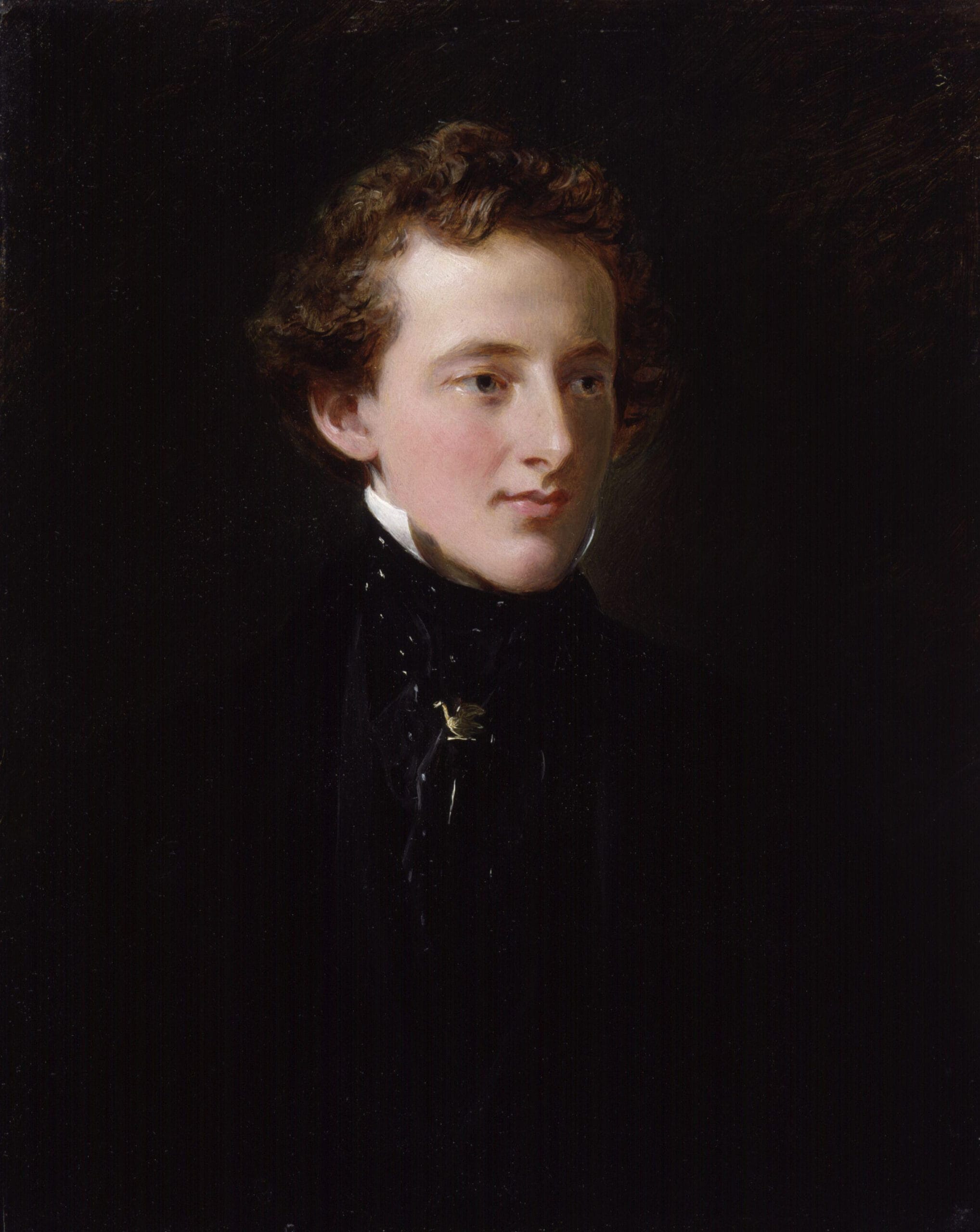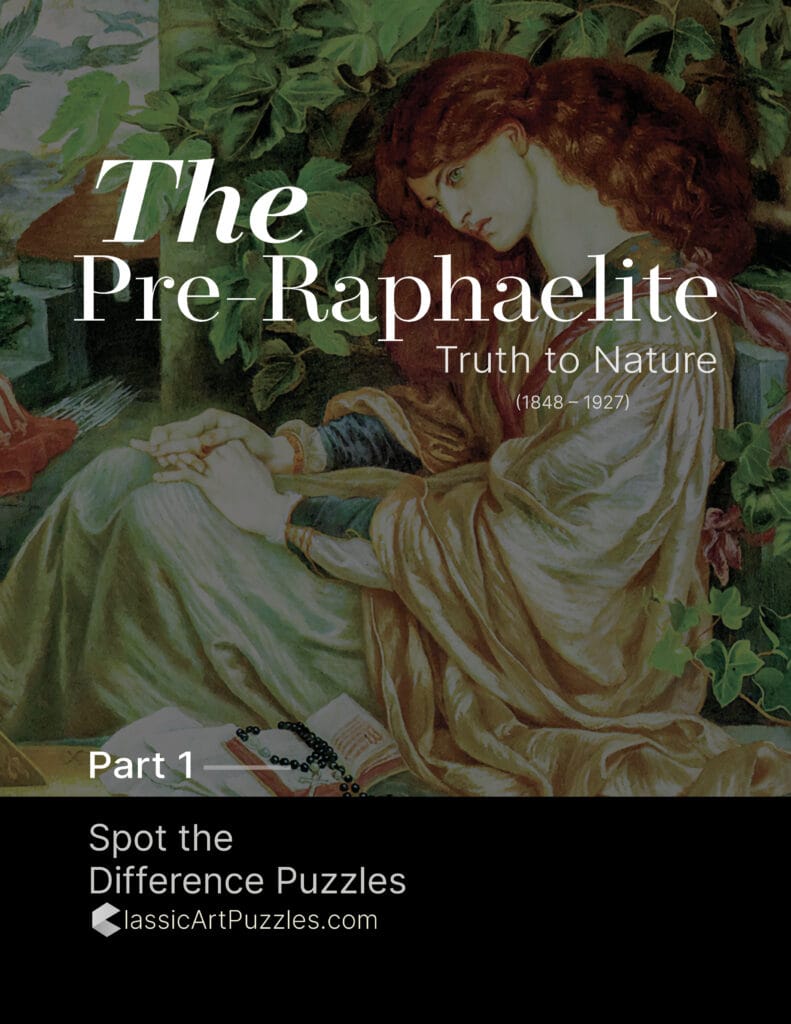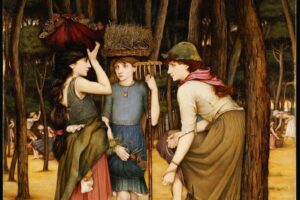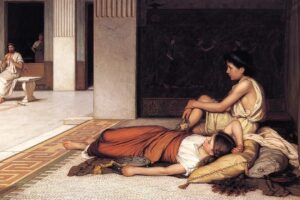Table of Contents
Overview
Isabella (1848–1849) by John Everett Millais is one of the founding works of the Pre-Raphaelite Brotherhood. The painting illustrates a scene from John Keats’s narrative poem Isabella; or, The Pot of Basil, itself derived from Boccaccio’s Decameron. At a dinner table, Isabella and her lover Lorenzo exchange tender glances, while her brothers, hostile and greedy, plot against them. Tension builds across the crowded scene, foreshadowing Lorenzo’s tragic fate.
Millais (1829–1896), only nineteen when he painted Isabella, demonstrated the Brotherhood’s ideals: truth to nature, sharp detail, and symbolic storytelling. Every gesture, color, and object serves meaning — from the orange peel curling on the table to the violent kick underfoot.
Exhibited at the Royal Academy in 1849, the painting startled Victorian viewers with its raw intensity and meticulous realism. Today, it stands as a landmark of Pre-Raphaelite art, uniting literature, symbolism, and moral passion in one dramatic vision.
About the Artist
Sir John Everett Millais (1829–1896) was a British painter and one of the three founders of the Pre-Raphaelite Brotherhood. Celebrated for his technical brilliance, he combined jewel-like naturalism with literary and historical subjects. His early works, like Isabella and Ophelia, embody the Brotherhood’s ideals of truth to nature and symbolic richness. Later, he became a leading portraitist and President of the Royal Academy, leaving a legacy that bridged revolutionary Romanticism and Victorian tradition.
The Story Behind the Painting
Keats, Boccaccio, and Isabella
The painting draws from Keats’s Isabella; or, The Pot of Basil (1818), a retelling of Boccaccio’s medieval tale. Isabella, a merchant’s sister, falls in love with Lorenzo, one of her family’s servants. Her brothers, greedy for wealth and status, murder Lorenzo. Heartbroken, Isabella retrieves his head and hides it in a basil pot, watering it with her tears until her death. Millais captures the dinner scene before tragedy erupts.
Brotherhood’s Manifesto
Painted at the dawn of the Pre-Raphaelite movement, Isabella embodies their rejection of academic conventions. The figures are not idealized but raw, intense, and individualized. The setting is detailed to the last glass of wine and cut loaf of bread, grounding the literary tale in tangible realism.
Moral Tensions
For Victorians, the story resonated as both romance and cautionary tale. Isabella’s love represents purity and truth, while her brothers embody greed and violence. Millais used the scene to dramatize the eternal conflict between love and avarice.
Composition and Subjects
Isabella and Lorenzo
At the right, Isabella leans toward Lorenzo, their hands almost touching across the table. Her pale face glows with tenderness, while Lorenzo’s gaze is steady and calm. Their intimacy sets them apart from the rest, a fragile bond in a hostile room.
The Brothers
At the left, Isabella’s brothers dominate the scene with aggressive gestures. One kicks a dog under the table, another slams down a walnut shell, their actions foreshadowing cruelty. Their angular forms and harsh expressions contrast with the lovers’ gentle posture.
Symbolic Details
The orange peel trailing across the table edge symbolizes the unraveling of fate. The spilled glass of wine hints at violence to come. Even the loyal dog, caught in the brother’s kick, reflects the theme of cruelty and innocence betrayed.
Table as Stage
The long table stretches across the canvas like a stage, figures lined in frieze-like order. Each gesture adds to the narrative: suspicion, hostility, longing, and complicity unfold in one crowded, symbolic banquet.
Art Style and Techniques
Early Pre-Raphaelite Naturalism
Millais painted with jewel-like clarity: the shine of glass, the grain of wood, the texture of fabric all rendered with astonishing realism. Nothing is blurred or generalized; every detail insists on truth to nature.
Symbolism in Detail
Objects carry meaning as strongly as figures. The oranges, walnuts, glass of wine, and even the tablecloth echo the themes of love, death, and betrayal. This symbolic layering became a hallmark of Pre-Raphaelite art.
Narrative Intensity
Unlike academic history paintings that idealized figures, Millais presented them with unflinching honesty. The result was unsettling to Victorian viewers — a realism so raw it seemed almost too close to life.
Legacy and Reflection
Reception in 1849
When shown at the Royal Academy, Isabella divided critics. Some were shocked by its harsh realism and angular figures, while others praised its freshness and detail. It marked the public debut of the Brotherhood, introducing their revolutionary approach.
Lasting Importance
Today, Isabella is recognized as a cornerstone of Pre-Raphaelitism. It encapsulates the movement’s ideals — fidelity to literature, precision in detail, and moral symbolism — while foreshadowing the tragic beauty that would define Millais’s career.
Featured in Our Collection
Isabella is proudly featured in our Pre-Raphaelite Spot-the-Difference Puzzle Flipbook. Its crowded table, intricate gestures, and symbolic details make it a fascinating puzzle subject. By searching for differences within Millais’s meticulous design, you sharpen observation while immersing yourself in one of the Brotherhood’s foundational works.
The lovers reach across the table, brothers scowl, symbols spill onto the cloth. In Isabella, Millais paints not just a dinner scene but the birth of tragedy — love set against greed, beauty against cruelty, the fragile against the violent.rett Millais gave the Pre-Raphaelite vision its first great voice — one of beauty, truth, and tragic poetry.
More About Artist

Sir John Everett Millais, 1st Baronet PRA (June 8, 1829 – August 13, 1896), was an English painter and illustrator, famously one of the founders of the Pre-Raphaelite Brotherhood. Born in Southampton, Millais showed early artistic talent and was the youngest student admitted to the Royal Academy Schools at age eleven. The Pre-Raphaelite Brotherhood, founded at his family home in London, challenged the prevailing artistic conventions by emphasizing naturalism, vivid detail, and complex symbolism. Millais became the most famous exponent of the style, though his later work evolved toward a more mainstream Victorian realism.
Artist Style and Movement
Millais’s early work epitomizes the Pre-Raphaelite style, notable for its vibrant colors, painstaking detail, and historical or literary subjects often laden with symbolism and emotional intensity. His early paintings often stirred controversy for their realism applied to sacred or historical themes. Later in life, Millais shifted towards a broader realism, which garnered him vast success and official acclaim, including presidency of the Royal Academy. Despite criticism from some contemporaries for this stylistic shift, his work remains crucial in understanding Victorian art.
Notable Works
- Mariana (1851), an iconic Pre-Raphaelite image of yearning and waiting, inspired by Tennyson’s poem.
- Isabella (1848–1849), a vivid narrative painting illustrating a tragic Renaissance tale in exquisite detail.
- Christ in the House of His Parents (1849-1850), a controversial yet seminal work depicting a realistic Holy Family at work.
- A Dream of the Past Sir Isumbras at the Ford (1857), a dramatic medieval scene emphasizing chivalry and heroism.
- Peace Concluded (1856), a romantic allegory celebrating harmony.
- Love and the Maiden (1877), an allegorical work showcasing Millais’s mature style.
- Charon and Psyche (1883), inspired by classical mythology and exploring themes of soul and death.
- Pine Woods at Viareggio (1888), a landscape reflecting his Italian influences.
- The Gentle Music of a Bygone Day (1873), evoking nostalgia and memory through genre scenes.
- The Waters of Lethe by the Plains of Elysium (1880), a symbolic painting referencing classical mythology.
- The North-West Passage (1874), a patriotic and historical narrative celebrated in British art.
- An Idyll of 1745 (1884), depicting a romanticized historical rural scene.
John Everett Millais’s career was a defining force in Victorian art, shaping the Pre-Raphaelite movement and influencing generations of British painters. His ability to combine technical virtuosity with deep narrative and emotional resonance made him both commercially successful and artistically influential. Alongside his dramatic early works, his later mastery of portraiture and landscape confirmed his status as one of the foremost artists of 19th-century Britain.




